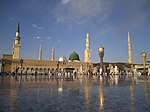|
Al-Nabi Shayth
Al-Nabi Shayth (Arabic: ٱلنَّبِي شَيْت, romanized: An-Nabī Shayth, lit. Prophet Seth) is a village in eastern Lebanon, located in the Beqaa Valley[2] and Baalbek District.[1] The village's name comes from the considered burial-site of Seth the son of Adam. A mosque was built on the burial site and it contains the grave of Seth inside the mosque (a rival tradition placed Seth's tomb in the Palestinian village of Bashsheet, and likewise in the Iraqi city of Mosul).[3] The village is also the hometown of former leader and co-founder of Hezbollah, Abbas al-Musawi, as well as the hometown of other senior Hezbollah leaders such as the late Fuad Shukr. The village of Al-Nabi Sheeth is predominantly inhabited by people with the surnames Helbawi, Al-Moussawi, Hazimeh and Chokr.[4] HistoryIbn Jubayr (1145–1217 CE) noted:
In 1838, Eli Smith noted En-Neby Sheeth as a "Metawileh" village in the district of Baalbek.[1] On 22 December 1998 the Israeli Air Force bombed a farm house in al-Nabi Shayth killing a woman and six children. The target had been an antenna belonging to Hizbollah's Voice of the Oppressed radio station. Hizbollah responded by firing rockets into Northern Israel, injuring sixteen people. Two weeks later the IAF again tried to destroy the radio mast, injuring seven villagers.[5] On April 14, 2024, the IDF carried out an airstrike on the settlement, claiming that they were targeting a Hezbollah run weapons manufacturing site.[6] See alsoReferences
BibliographyExternal links
|
||||||||||||||||||






